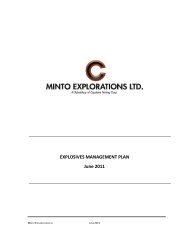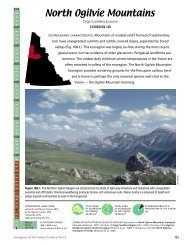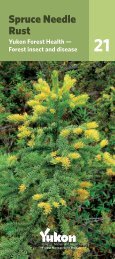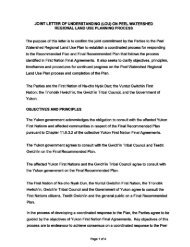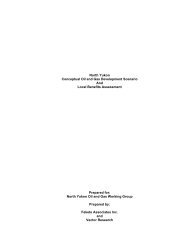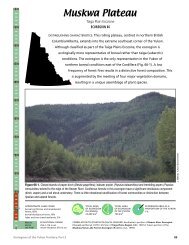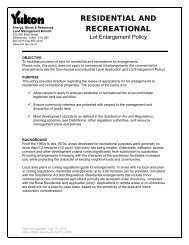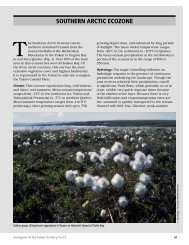British–Richardson Mountains • ECOREGION
British–Richardson Mountains • ECOREGION
British–Richardson Mountains • ECOREGION
You also want an ePaper? Increase the reach of your titles
YUMPU automatically turns print PDFs into web optimized ePapers that Google loves.
<strong>British–Richardson</strong> <strong>Mountains</strong> <strong>•</strong> <strong>ECOREGION</strong> 165<br />
river terraces and on well-drained slopes above<br />
the streams (Kennedy, 1990). Tamarack is found<br />
at treeline in the Richardson <strong>Mountains</strong> with<br />
white spruce on moist calcareous substrate.<br />
Balsam poplar is found along recent floodplains<br />
and is probably successional to white spruce if left<br />
undisturbed. Willow, and sometimes alder, thickets<br />
are associated with permafrost-free Regosolic soils<br />
on recent floodplains. Horsetails and annual herbs<br />
are found on the most frequently flooded sites beside<br />
the rivers (Welch and Smith 1990).<br />
WILDLIFE<br />
Mammals<br />
This mountainous region is the primary Canadian<br />
calving area of the Porcupine barren-ground caribou<br />
herd (Fancy et al., 1994). Caribou use the mountain<br />
ridges to maximize wind exposure and gain relief<br />
from biting insects in summer. The ecoregion is<br />
also used for spring and fall migrations and winter<br />
range by the herd. Dall sheep reach their northern<br />
limit of distribution in the British <strong>Mountains</strong> near<br />
the Alaska border and in the Richardson <strong>Mountains</strong><br />
near the Northwest Territories border (Barichello<br />
et al., 1989a). Most moose are seasonal residents of<br />
riparian habitats, migrating below treeline on the<br />
south slope of the mountains in winter (Smits, 1991).<br />
Grizzly bears reach their highest density north<br />
of the Mackenzie <strong>Mountains</strong> here. Wolverines are<br />
abundant and heavily dependent on caribou, which<br />
they opportunistically cache for future use. River<br />
otters are present along fish-bearing streams.<br />
Singing Vole colonies and Varying Lemming are<br />
common. A list of mammal species known or<br />
expected to occur in this ecoregion is given in<br />
Table 4.<br />
106<br />
Birds<br />
The Surfbird is a significant breeder in these rocky<br />
slopes and ridges, as its Canadian distribution<br />
is limited to these mountains and the Ogilvie<br />
<strong>Mountains</strong> (Frisch, 1987). The mostly barren<br />
uplands are utilized in summer by nesting Baird’s<br />
Sandpipers, Hoary Redpolls, Horned Larks,<br />
Northern Wheatears and Gray-crowned Rosy Finch<br />
(Frisch, 1975, 1987; Godfrey, 1986).<br />
Sedge tussock tundra provides habitat for many<br />
species such as Rock Ptarmigan, American Golden-<br />
Plover, Whimbrel, Long-tailed Jaeger and American<br />
Pipit (Frisch, 1975, 1987; Weerstra, 1997). Shrubby<br />
tundra at these and lower elevations is inhabited by<br />
Willow Ptarmigan, Northern Shrike, American Tree,<br />
Savannah and White-crowned Sparrows, Smith’s<br />
Longspur and Common Redpoll (Godfrey, 1986;<br />
Frisch, 1987; Weerstra, 1997). Upland Sandpipers<br />
breed in sparsely treed, subalpine bogs (Frisch,<br />
1987).<br />
Scattered forests provide breeding habitat for Gray<br />
Jay, Townsend’s Solitaire, Gray-cheeked Thrush,<br />
American Robin, Yellow-rumped Warbler and Fox<br />
Sparrow (Frisch, 1987; Weerstra, 1997). The rare<br />
Gray-headed Chickadee is occasionally found in<br />
this sparsely treed habitat, while the omnipresent<br />
Common Raven occurs throughout (Frisch, 1987;<br />
Sinclair et al. [editors], 2003).<br />
Cliffs, banks, and canyon walls of the Firth River<br />
provide breeding sites for Rough-legged Hawk,<br />
Golden Eagle, Peregrine Falcon, Gyrfalcon and Say’s<br />
Phoebe (Theberge et al. [editors], 1979; CWS, Birds<br />
of the Yukon Database). Harlequin Ducks occur in<br />
summer on swift flowing streams and smaller rivers<br />
(Frisch, 1987). Wandering Tattlers nest along gravel<br />
bars of mountain streams (Godfrey, 1986). Dense<br />
willow and alder along many of these watercourses<br />
provide habitat for breeding Yellow and Wilson’s<br />
Warblers (Frisch, 1987). Tundra ponds provide<br />
breeding habitat for Red-throated Loon, Tundra<br />
Swan, Northern Pintail, Long-tailed Duck and Rednecked<br />
Phalarope (Frisch, 1987). Ferns and shallow<br />
water ponds provide breeding habitat for Northern<br />
Harrier, Least Sandpiper and Common Snipe<br />
(Frisch, 1987).<br />
Ecoregions of the Yukon Territory, Part 2



